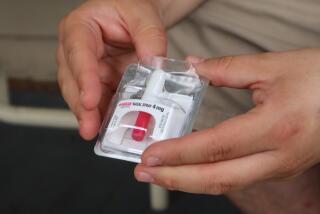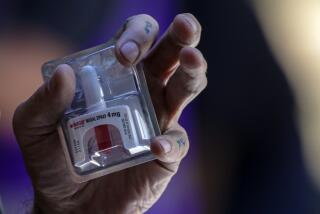Improving California’s clean-needle program
California finally caught up with most of the nation in 2004 when it allowed some drug addicts access to clean needles. The five-year pilot program permitted adults to buy up to 10 needles at a time without a prescription, and that, in turn, gave addicts an alternative to using whatever syringe — however dirty or dangerous — they could find. This helped curb the spread of hepatitis and other serious diseases, and protected the health not just of needle users but of the public generally.
Now, as the pilot program is due to expire, the Legislature is considering whether to push back the sunset date and keep the program intact, with its existing limitations. Lawmakers can do better. They can save the state money, reach more addicts and do more to block the spread of disease by allowing any pharmacist in the state to choose whether to provide needles without a prescription. The Senate has already approved SB 1029 by Sen. Leland Yee (D-San Francisco). The Assembly should do the same and send this worthy bill to the governor.
The current system is too restrictive. It limits the clean-needle program to those local jurisdictions that opt in to it. That’s fine here in Los Angeles, where county health officials recognize the prevalence of AIDS and other diseases, and the crossover between the population of intravenous drug users and those carrying infectious diseases. But in much of the state, local officials lack either the resources to participate, the awareness of the problem or the political will to do anything to improve the health of people addicted to illegal drugs.
Yee’s bill transfers the key decision — whether to provide needles without a prescription — from local politicians to doctors and pharmacists. Pharmacists would have the power to decide whether to sell up to 30 clean syringes at a time to an adult without a prescription; county boards of supervisors would no longer be required to opt in. State agencies would provide information about drug treatment and disease screening, to be distributed to needle buyers.
The current law has served its purpose. A required evaluation — published July 17 — shows no increase in the rate of drug use, crime or unsafe disposal of needles. It shows that the risk of infection is lower in counties where drug users can get clean needles, although more study is needed to determine whether the current law has directly produced a decrease in infection rates.
Like the current law, SB 1029 includes a sunset provision, which will give future lawmakers an opportunity to gauge the program’s effectiveness and make any appropriate adjustments. Until then, the bill would ensure that disease prevention remains a matter controlled by physicians and pharmacists rather than local politicians.
More to Read
Get the L.A. Times Politics newsletter
Deeply reported insights into legislation, politics and policy from Sacramento, Washington and beyond. In your inbox three times per week.
You may occasionally receive promotional content from the Los Angeles Times.










